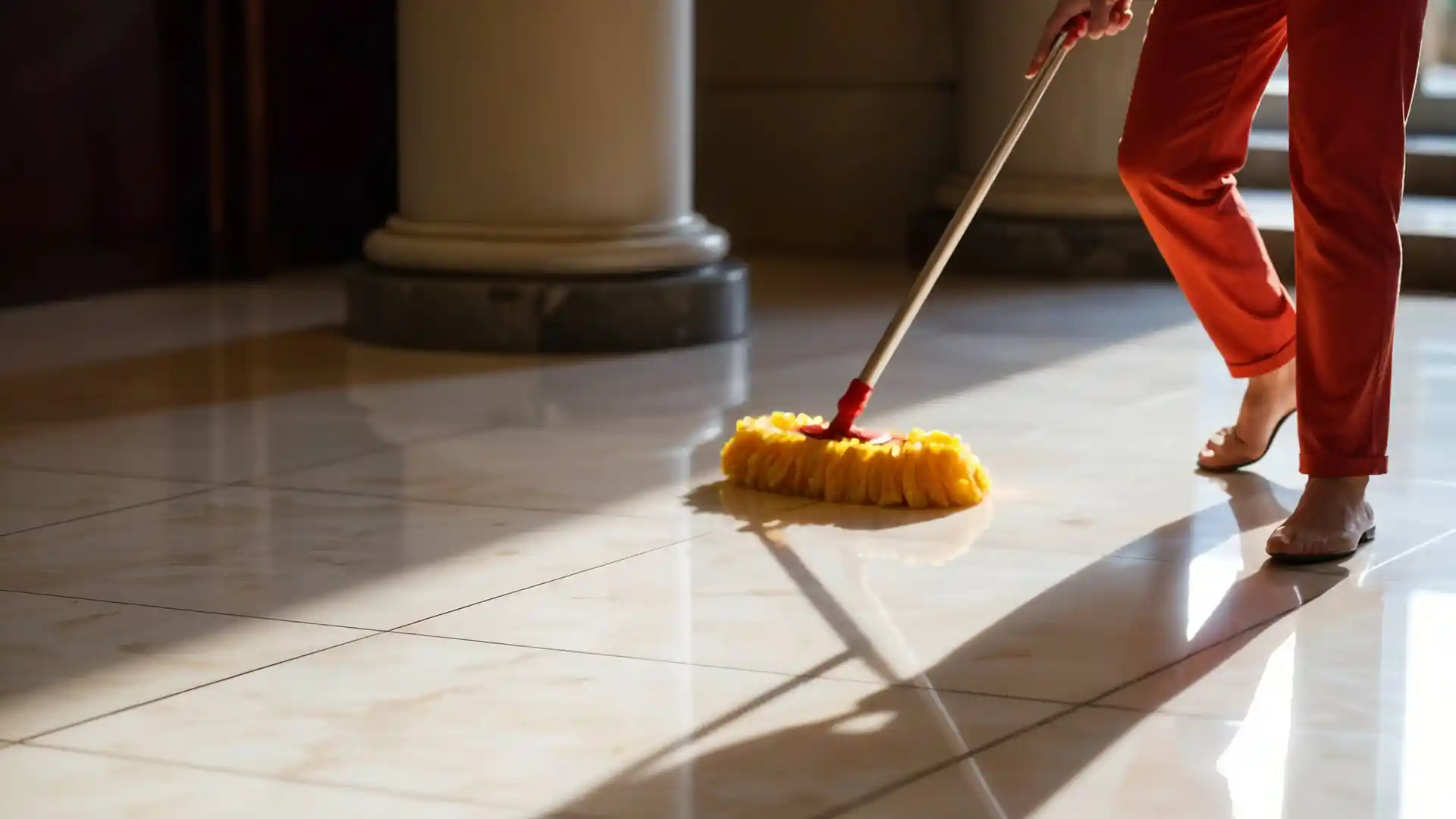How to Care for Marble Floors: Keep Them Shining for Years
Marble floors are synonymous with luxury, elegance, and timeless beauty. Whether in a grand foyer, a modern bathroom, or a stylish kitchen, marble instantly elevates any space with its natural veining and sheen. However, as stunning as marble is, it’s also delicate and requires specific care to maintain its luster and longevity. Without the right maintenance, marble can lose its polish, stain easily, or become dull over time.
In this guide, we’ll explore how to care for your marble floors, protect them from damage, and preserve their breathtaking appeal. And when your marble needs expert attention, Service Master Albino, the leading disaster restoration and cleaning company, is your trusted partner for professional marble cleaning and restoration services.
Understanding Your Marble Floors
Marble is a natural stone composed primarily of calcium carbonate. This makes it porous and sensitive to acids and harsh chemicals, which can easily etch or stain the surface. Because of this, marble care involves more than just sweeping and mopping — it requires gentle, consistent maintenance and the right cleaning techniques.
1. Daily Cleaning and Dusting
The first rule of marble maintenance is preventing surface scratches and dirt buildup. Dust, grit, and sand act like sandpaper when dragged across marble floors, leading to fine scratches that dull the surface.
- Sweep or dust daily: Use a soft, dry microfiber mop or dust mop to remove debris. Avoid traditional brooms with stiff bristles, which can scratch the surface.
- Vacuum carefully: If you use a vacuum, make sure it has a hard floor setting and a soft brush attachment to prevent scuffing.
This simple habit helps preserve your marble’s finish and keeps it looking pristine.
2. Mopping the Right Way
When it’s time for a deeper clean, it’s important to use the right products and techniques. Marble doesn’t respond well to standard floor cleaners, especially those containing acids like vinegar, lemon, or bleach.
- Use a pH-neutral cleaner: Opt for a cleaner specifically formulated for marble or natural stone. You can also use warm water mixed with a few drops of mild dish soap.
- Avoid excess water: Marble is porous, and standing water can seep into the stone, causing discoloration. Always wring out your mop thoroughly before cleaning.
- Dry immediately: After mopping, use a soft towel or microfiber cloth to dry the floor completely. This prevents water spots and streaks.
3. Seal Your Marble Floors
Sealing is one of the most effective ways to protect marble from stains and etching. A marble sealer acts as a barrier, reducing the stone’s porosity and making it easier to clean up spills before they cause damage.
- How often to seal: Depending on traffic and the type of marble, sealing should typically be done every 6 to 12 months.
- Test the seal: To check if your marble needs resealing, sprinkle a few drops of water on the surface. If it absorbs quickly, it’s time for a new coat of sealer.
If you’re unsure about sealing or need expert help, Service Master Albino offers professional marble sealing and restoration services to keep your floors protected and radiant.
4. Preventing Stains and Etching
Marble is highly reactive to acidic substances — even small spills can leave permanent marks if not addressed immediately. Common culprits include lemon juice, vinegar, coffee, and wine.
- Wipe spills immediately: Use a damp cloth to blot (not rub) the spill. Rubbing spreads the liquid and may worsen the stain.
- Use mats and rugs: Place entry mats at doors and area rugs in high-traffic areas like hallways and kitchens to reduce wear and tear.
- Add felt pads to furniture: This prevents scratching when chairs or tables are moved.
Remember: prevention is the best way to keep marble looking flawless.
5. Dealing with Stains and Etching
Even with the best care, accidents happen. When your marble develops stains or dull spots, it’s important to treat them correctly.
- For organic stains (like coffee or wine): Mix baking soda with water to form a paste, apply it to the stain, cover it with plastic wrap, and leave it for 24 hours. Then gently wipe it clean.
- For oil-based stains (like grease): Use a soft cloth dampened with a small amount of acetone or ammonia. Always do spot test first
- For etch marks: These dull, light-colored spots occur from acid exposure. Since they involve surface damage, it’s best to have them professionally polished.
Service Master Albino specializes in marble polishing and restoration, using advanced techniques to remove etches, stains, and dullness — restoring your floor’s natural brilliance.
6. Regular Professional Maintenance
Even with meticulous care, marble floors benefit from professional cleaning and restoration every 12 to 18 months. Over time, foot traffic, spills, and cleaning products can cause micro-abrasions that dull the stone’s surface.
Professional services from Service Master Albino include:
- Deep cleaning with specialized marble-safe solutions
- Honing and polishing to remove scratches and dullness
- Resealing for lasting protection
- Restoration of worn or damaged marble floors
With their team of highly trained technicians and cutting-edge equipment, Service Master Albino ensures your marble floors retain their luxurious finish and continue to impress for years.
7. Avoid These Common Mistakes
Many homeowners unknowingly damage their marble floors with improper cleaning habits. Here are some pitfalls to avoid:
- Never use acidic cleaners (vinegar, lemon, or bleach).
- Avoid abrasive pads or brushes — they scratch the surface.
- Don’t leave rugs with rubber backing on marble — they trap moisture and discolor the stone.
- Skip waxes and polishes meant for other flooring types — they can dull the marble’s natural shine.
Final Thoughts
Caring for marble floors is about consistency, gentleness, and protection. With regular cleaning, proper sealing, and mindful maintenance, your marble will retain its elegance and charm for decades.
However, when your marble needs a deeper touch — from polishing to restoration — trust Service Master Albino, the leading name in disaster restoration and professional cleaning. Their expertise ensures your marble floors not only shine but stay strong, resilient, and beautiful through the years.
FAQ
1. How often should I clean my marble floors?
You should dust or sweep your marble floors daily to prevent dirt and grit from scratching the surface. For deeper cleaning, mop once or twice a week using a pH-neutral cleaner designed for marble or natural stone. Always dry the floor after mopping to prevent water spots and streaks.
2. Can I use vinegar or lemon to clean marble floors?
No. Avoid acidic cleaners like vinegar, lemon juice, or ammonia on marble surfaces. These acids can etch the marble, leaving dull marks or discoloration. Instead, use a gentle, pH-neutral cleaner or warm water with a few drops of mild dish soap.
3. How can I protect my marble floors from scratches?
Place mats at entryways to trap dirt and grit, use area rugs in high-traffic zones, and attach felt pads to furniture legs. Regular dusting also helps prevent tiny abrasive particles from scratching the surface.
4. What should I do if something spills on my marble floor?
Blot the spill immediately using a soft, damp cloth — do not rub, as that can spread the liquid. For stubborn stains, use a poultice made from baking soda and water, or contact a professional cleaning service like Service Master Albino for expert marble stain removal.
5. Do marble floors need to be sealed?
Yes, sealing is essential. Marble is porous and can absorb liquids, leading to stains. Apply a high-quality marble sealer every 6 to 12 months, depending on foot traffic and usage. To test if resealing is needed, sprinkle a few drops of water on the surface — if it absorbs quickly, it’s time to reseal.
6. How do I remove dull spots or etches from marble floors?
Dull spots or etch marks are caused by acid exposure. These can’t usually be removed with DIY cleaning. Professional marble restoration services, like those offered by Service Master Albino, use specialized polishing and honing techniques to restore the marble’s original shine and smoothness.
7. Is marble flooring hard to maintain?
Marble requires more attention than ceramic or vinyl flooring, but with proper care, it’s manageable. Regular cleaning, immediate spill cleanup, and periodic sealing go a long way in maintaining its natural beauty and durability.
8. Can marble floors be polished at home?
You can lightly buff marble floors using a soft cloth or microfiber mop to enhance shine. However, for deeper polishing — especially to remove etches or scratches — professional services are recommended. Service Master Albino offers expert marble polishing to rejuvenate dull floors safely and effectively.
9. What’s the best way to clean grout between marble tiles?
Use a soft brush and a gentle, non-acidic cleaner specifically designed for natural stone. Avoid bleach or harsh chemicals, as they can damage the marble and grout. For stubborn buildup, consider a professional deep-cleaning service to restore the grout’s appearance without harming the stone.
10. How can Service Master Albino help with marble floor maintenance?
Service Master Albino is a leading disaster restoration and cleaning company specializing in marble floor care. Their services include deep cleaning, polishing, sealing, and restoring damaged or stained marble surfaces. With advanced equipment and expert technicians, they ensure your marble floors remain spotless, glossy, and long-lasting.

